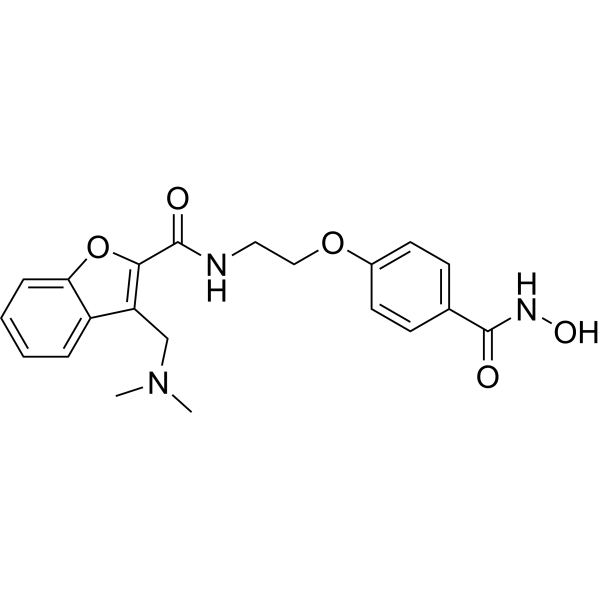Home
Products
Abexinostat



| Product Name | Abexinostat |
| Price: | Inquiry |
| Catalog No.: | CN00193 |
| CAS No.: | 783355-60-2 |
| Molecular Formula: | C21H23N3O5 |
| Molecular Weight: | 397.42 g/mol |
| Purity: | >=98% |
| Type of Compound: | Alkaloids |
| Physical Desc.: | Powder |
| Source: | |
| Solvent: | Chloroform, Dichloromethane, Ethyl Acetate, DMSO, Acetone, etc. |
| SMILES: | ONC(=O)c1ccc(cc1)OCCNC(=O)c1oc2c(c1CN(C)C)cccc2 |
| Contact us | |
|---|---|
| First Name: | |
| Last Name: | |
| E-mail: | |
| Question: | |
| Description | Abexinostat (CRA 024781) is a novel pan-HDAC inhibitor mostly targeting HDAC1 with Ki of 7 nM. |
| Target | HDAC1:7 nM (Ki) HDAC3/SMRT:8.2 nM (Ki) HDAC6:17 nM (Ki) HDAC2:19 nM (Ki) HDAC10:24 nM (Ki) HDAC8:280 nM (Ki) |
| In Vitro | Abexinostat (CRA 024781) exhibits potent antitumor activity against a variety of tumor cell lines with GI50% ranging from 0.15 μM to 3.09 μM. Abexinostat (CRA 024781) also has an antiproliferative effect on HUVEC endothelial cells with GI50% of 0.43 μM. Abexinostat (CRA 024781) treatment causes dose-dependent accumulation of both acetylated histones and acetylated tubulin in HCT116 or DLD-1 cells, induces expression of p21, and leads to PARP cleavage and accumulation of the γH2AX[1]. Inhibition of HDAC enzymes by Abexinostat (CRA 024781) leads to a significant reduction in the transcription of genes specifically associated with HR, including RAD51. Consistent with inhibition of HR, Abexinostat (CRA 024781) treatment results in a decreased ability to perform homology directed repair of I-SceI-induced chromosome breaks in transfected CHO cells[2]. Abexinostat (CRA 024781) induces S phase depletion, G2 cell cycle arrest, and apoptosis in soft tissue sarcoma (STS) cells. Abexinostat (CRA 024781) induces Rad51 transcriptional repression in STS cells potentially mediated via enhanced E2F1 binding to the Rad51 proximal promoter[3]. |
| In Vivo | Abexinostat (CRA 024781) parenterally administered to mice harboring HCT116 or DLD-1 colon tumor xenografts results in a statistically significant reduction in tumor growth. Inhibition of tumor growth is accompanied by an increase in the acetylation of α-tubulin in peripheral blood mononuclear cells, and an alteration in the expression of many genes in the tumors, including several involved in apoptosis and cell growth[1]. |
| Cell Assay | Ten tumor cell lines and HUVEC are cultured for at least two doubling times, and growth is monitored at the end of compound exposure using an Alamar blue fluorometric cell proliferation assay. The compound is assayed in triplicate wells in 96-well plates at nine concentrations using half-log intervals ranging from 0.0015 to 10 μmol/L. The final DMSO concentration in each well is 0.15%. The concentration required to inhibit cell growth by 50% and 95% confidence intervals are estimated from nonlinear regression using a four-parameter logistic equation[1]. |
| Animal Admin | HCT116 and DLD-1 tumor cells are implanted s.c. in female BALB/c nu/nu mice at 3×106 per mouse. Treatment with Abexinostat (CRA 024781) started when the average tumor volume is -100 mm[1]. Mice bearing human colon tumor xenografts are dosed i.v. with Abexinostat (CRA 024781) using various dosages and schedules to assess the antitumor activity of Abexinostat (CRA 024781) [1]. |
| Density | 1.3±0.1 g/cm3 |
| Exact Mass | 397.163757 |
| PSA | 107.53000 |
| LogP | 1.68 |
| Storage condition | -20℃ |